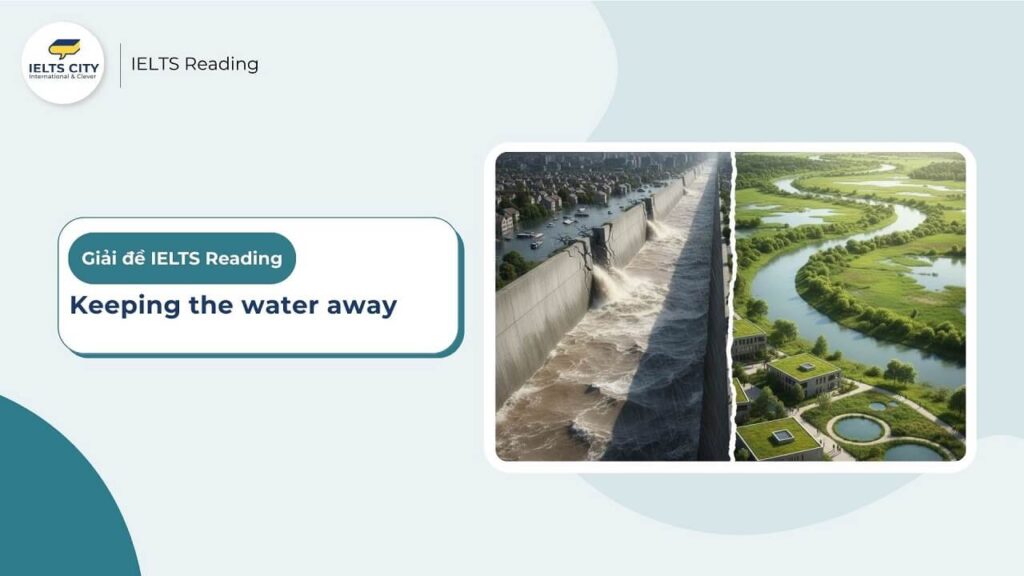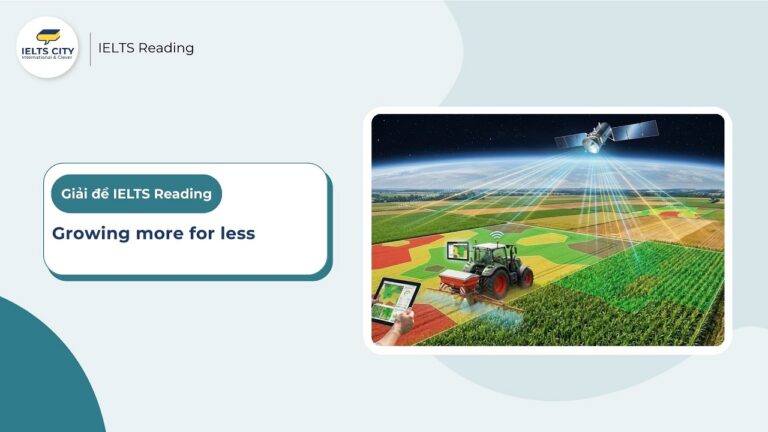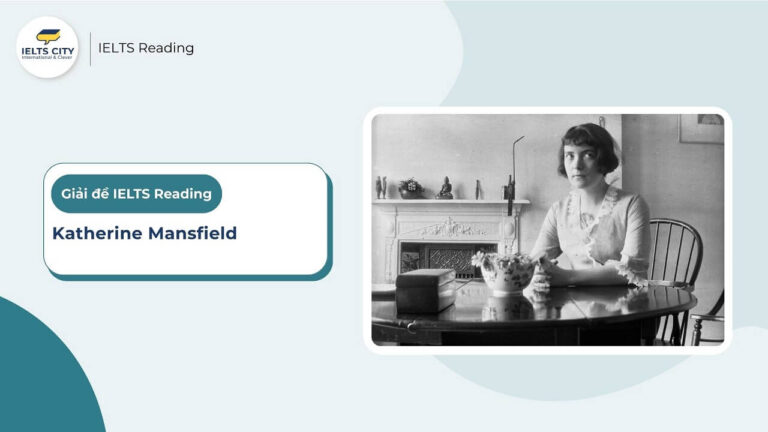
Nội dung chính
ToggleBài đọc
Keeping the water away
New approaches to flood control
A. Recently, winter floods on the rivers of central Europe have been among the worst for 600 to 700 years, and dams and dykes (protective sea walls) have failed to solve the problem. Traditionally, river engineers have tried to get rid of the water quickly, draining it off the land and down to the sea in rivers reengineered as high-performance drains. But however high they build the artificial riverbanks, the floods keep coming back. And when they come, they seem to be worse than ever
B. Engineers are now turning to a different plan: to sap the water’s destructive strength by dispersing it into fields; forgotten lakes and floods plains. They are reviving river bends and marshes to curb the flow, and even plugging city drains to encourage floodwater to use other means to go underground. Back in the days when rivers took a winding path to the sea, floodwaters lost force and volume while meandering across flood plains and inland deltas, but today the water tends to have a direct passage to the sea. This means that, when it rains in the uplands, the water comes down all at once.
C. Worse, when the flood plains are closed off, the river’s flow downstream becomes more violent and uncontrollable; by turning complex river systems into the simple mechanics of a water pipe, engineers have often created danger where they promised safety. The Rhine, Europe’s most engineered river; is a good example. For a long time engineers have erased its backwaters and cut it off from its plain. The aim was partly to improve navigation, and partly to speed floodwaters out of Alps and down to the North Sea. Now, when it rains in the Alps, the peak flows from several branches of the Rhine coincide where once they arrived separately, and with four-fifths of the Lower Rhine’s flood plain barricaded off, the waters rise. The result is more frequent flooding and greater damage. The same thing has happened in the US on the Mississippi river, which drains the world’s second largest river catchment into the Gulf of Mexico. Despite some $7 billion spent over the last century on levees (embankments) the situation is growing worse.
D. Specialists in water control now say that a new approach is needed – one which takes the whole landscape into consideration. To help keep London’s feet dry, the UK Environment Agency is reflooding 10 square kilometres of the ancient flood plain of the River Thames outside Oxford. Nearer to London, it has spent £100 million creating new wetlands and a relief channel across 16 kilometres of flood plain. Similar ideas ate being tested in Austria, in one of Europe’s largest river restorations to date. The engineers calculate that the restored flood plain of the Drava River can now store up to 10 million cubic metres of floodwater, and slow down storm surges coming out of the Alps by more than an hour, protecting towns not only in Austria, but as far downstream as Slovenia and Croatia.
E. The Dutch, for whom preventing floods is a matter of survival, have gone furthest. This nation, built largely on drained marshes and seabed, has had several severe shocks in the last two decades, when very large numbers of people have had to be evacuated. Since that time, the Dutch have broken one of their most enduring national stereotypes by allowing engineers to punch holes in dykes. They plan to return up to a sixth of the country to its former waterlogged state in order to better protect the rest.
F. Water use in cities also needs to change. At the moment, cities seem to create floods; they are concreted and paved so that rains flow quickly into rivers. A new breed of ‘soft engineers’ wants cities to porous, Berlin is one place where this is being done. Tough new rules for new developments mean that drains will be prevented from becoming overloaded after heavy rains. Architects of new urban buildings are diverting rainwater from the roofs for use in toilets and the irrigation of roof gardens, while water falling onto the ground is collected in ponds, or passes underground through porous paving. One high-tech urban development can store a sixth of its annual rainfall, and reuse most of the rest.
G. Could this be expanded to protect a whole city? The test case could Los Angeles. With non-porous surfaces covering 70% of the city, drainage is a huge challenge. Billions of dollars have been spent digging huge drains and concreting riverbeds, but many communities still flood regularly. Meanwhile this desert city ships water from hundreds of kilometres away to fill its taps and swimming pool. Los Angeles has recently launched a new scheme to utilise floodwater in the Sun Valley section of the city. The plan is to catch the rain that falls on thousands of driveways, parking lots and rooftops in the valley. Trees will soak up water from parking lots; houses and public buildings will capture roof water to irrigate gardens and parks, and road drains will empty into old gravel pits to recharge the city’s underground water reserves. Result: less flooding and more water for the city. It may sound expensive, until we realise how much is spent trying to drain cities and protect areas from flooding, and how little this method achieves.
Kiến thức cần nắm:
Câu hỏi
Questions 1-6
Reading Passage 2 has seven paragraphs, A-G,
Which paragraph contains the following information?
Write the correct letter, A-G, in boxes 1-6 on your answer sheet
1. how legislation has forced building designers to improve water use
2. two reasons why one river was isolated from its food plain
3. how natural water courses in the past assisted flood control
4. an example of flood control on one river, affecting three countries
5. a country which has partly destroyed one of its most typical features in order to control water
6. the writer’s comment on the comparative cost effectiveness of traditional flood control and newer methods
Kiến thức cần nắm:
Questions 7-8
Choose TWO letters A-E.
Write the correct letter, in boxes 7-8 on your answer sheet
According to the article, which TWO of these statements are true of the new approach to flood control?
A. It aims to slow the movement of water to the sea.
B. It aims to channel water more directly into rivers.
C. It will cost more than twice as much as former measures.
D. It will involve the loss of some areas of land.
E. It has been tested only in The Netherlands.
Kiến thức cần nắm:
Questions 9-13
Complete the sentences below.
Choose NO MORE THAN TWO WORDS from the passage for each answer. Write your answers in boxes 9-13 on your answer sheet.
9. Some of the most severe floods for many centuries have recently occurred in parts of ________
10. The Rhine and the ________ rivers have experienced similar problems with water control
11. An area near Oxford will flooded to protect the city of ________
12. Planners who wish to allow water to pass more freely through city surfaces are called ________
13. A proposal for part of the city of ________ could show whether small-scale water projects could apply on a large scale.
Kiến thức cần nắm:
Đáp án kèm phân tích
Questions 1-6: Matching Information
1. how legislation has forced building designers to improve water use
- Đáp án: F
- Giải thích: Đoạn F đề cập đến việc Berlin đang áp dụng các “quy tắc mới cứng rắn” (Tough new rules) cho các công trình mới. “Tough new rules” chính là “legislation” (luật lệ/quy định). Những quy tắc này buộc các “kiến trúc sư” (Architects) – tức là “building designers” – phải chuyển hướng nước mưa vào nhà vệ sinh hoặc tưới vườn, thay vì đổ thẳng ra cống.
- Vị trí và trích dẫn: Đoạn F.”Tough new rules for new developments mean that drains will be prevented from becoming overloaded… Architects of new urban buildings are diverting rainwater from the roofs for use in toilets and the irrigation of roof gardens…”
2. two reasons why one river was isolated from its flood plain
- Đáp án: C
- Giải thích: Đoạn C lấy ví dụ về sông Rhine, nói rằng các kỹ sư đã “cắt nó khỏi vùng đồng bằng ngập lũ” (cut it off from its plain). Đoạn văn sau đó nêu rõ hai lý do (two reasons) cho việc này: “một phần là để cải thiện hàng hải” (improve navigation) và “một phần là để tăng tốc độ nước lũ” (speed floodwaters).
- Vị trí và trích dẫn: Đoạn C.”…engineers have erased its backwaters and cut it off from its plain. The aim was partly to improve navigation, and partly to speed floodwaters out of Alps and down to the North Sea.”
3. how natural water courses in the past assisted flood control
- Đáp án: B
- Giải thích: Đoạn B mô tả cách các con sông trong quá khứ (“Back in the days”) hỗ trợ kiểm soát lũ lụt một cách tự nhiên. Khi sông đi theo “con đường quanh co” (winding path), nước lũ đã “mất lực và khối lượng” (lost force and volume) khi chảy qua các vùng ngập lũ. Đây chính là cách các dòng chảy tự nhiên giúp kiểm soát lũ.
- Vị trí và trích dẫn: Đoạn B.”Back in the days when rivers took a winding path to the sea, floodwaters lost force and volume while meandering across flood plains…”
4. an example of flood control on one river, affecting three countries
- Đáp án: D
- Giải thích: Đoạn D đưa ra một ví dụ về việc khôi phục đồng bằng ngập lũ của sông Drava (one river) ở Áo. Đoạn văn nêu rõ rằng biện pháp này bảo vệ các thị trấn không chỉ ở Áo (Austria) mà còn ở hạ lưu xa tới Slovenia và Croatia (three countries).
- Vị trí và trích dẫn: Đoạn D.”…the restored flood plain of the Drava River can… protect[ing] towns not only in Austria, but as far downstream as Slovenia and Croatia.”
5. a country which has partly destroyed one of its most typical features in order to control water
- Đáp án: E
- Giải thích: Đoạn E nói về “người Hà Lan” (The Dutch). Đặc điểm điển hình (typical features) của họ là các “con đê” (dykes). Đoạn văn nói rằng họ đã “phá vỡ một trong những khuôn mẫu dân tộc lâu bền nhất” (broken one of their most enduring national stereotypes) bằng cách cho phép kỹ sư “đục lỗ trên các con đê” (punch holes in dykes). Đây chính là việc “phá hủy một phần” đặc điểm điển hình của họ.
- Vị trí và trích dẫn: Đoạn E.”…the Dutch have broken one of their most enduring national stereotypes by allowing engineers to punch holes in dykes.”
6. the writer’s comment on the comparative cost effectiveness of traditional flood control and newer methods
- Đáp án: G
- Giải thích: Đoạn G kết thúc bằng một bình luận so sánh chi phí và hiệu quả. Người viết nói rằng phương pháp mới (ở Los Angeles) “có vẻ đắt đỏ” (sound expensive) cho đến khi chúng ta nhận ra “chúng ta đã chi bao nhiêu” (how much is spent) cho phương pháp truyền thống (thoát nước) và “phương pháp này đạt được ít ỏi thế nào” (how little this method achieves). Đây là một bình luận trực tiếp về “comparative cost effectiveness” (hiệu quả chi phí so sánh).
- Vị trí và trích dẫn: Đoạn G.”It may sound expensive, until we realise how much is spent trying to drain cities… and how little this method achieves.”
Đăng ký nhận tư vấn miễn phí
Ưu đãi học phí lên đến 40%
& Cơ hội nhận học bổng trị giá 2.000.000 VNĐ
Đăng ký nhận tư vấn miễn phí
Ưu đãi học phí lên đến 40%
________
Questions 7-8: Multiple Choice
- Đáp án: A, D
- Giải thích:
- A. It aims to slow the movement of water to the sea.
- Giải thích: Đúng. Đoạn B nói cách tiếp cận mới là “làm tiêu hao sức mạnh phá hoại của nước” (sap the water’s destructive strength) và “kiềm chế dòng chảy” (curb the flow). Điều này trái ngược với cách làm cũ là “thoát nước nhanh” (get rid of the water quickly).
- Vị trí và trích dẫn: Đoạn B.
- D. It will involve the loss of some areas of land.
- Giải thích: Đúng. Phương pháp mới bao gồm việc “phân tán [nước] vào các cánh đồng” (dispersing it into fields) (Đoạn B), “tái ngập 10 km vuông” (reflooding 10 square kilometres) (Đoạn D), và trả lại “1/6 đất nước về trạng thái ngập nước” (return up to a sixth of the country to its former waterlogged state) (Đoạn E). Đây chính là việc chấp nhận mất đi một số diện tích đất khô.
- Vị trí và trích dẫn: Đoạn B, D, E.
- A. It aims to slow the movement of water to the sea.
Questions 9-13: Sentence Completion
9. Some of the most severe floods for many centuries have recently occurred in parts of ________
- Đáp án: central Europe
- Giải thích: Câu đầu tiên của bài đọc nói rằng các trận lụt mùa đông gần đây trên các con sông ở “trung tâm châu Âu” (central Europe) là một trong những trận tồi tệ nhất.
- Vị trí và trích dẫn: Đoạn A.”Recently, winter floods on the rivers of central Europe have been among the worst for 600 to 700 years…”
10. The Rhine and the ________ rivers have experienced similar problems with water control
- Đáp án: Mississippi
- Giải thích: Đoạn C mô tả các vấn đề của sông Rhine, sau đó kết luận: “Điều tương tự cũng đã xảy ra ở Mỹ trên sông Mississippi” (The same thing has happened in the US on the Mississippi river).
- Vị trí và trích dẫn: Đoạn C.
11. An area near Oxford will flooded to protect the city of ________
- Đáp án: London
- Giải thích: Đoạn D nói rằng “Để giúp giữ cho London khô ráo” (To help keep London’s feet dry), Cơ quan Môi trường Vương quốc Anh đang tái ngập một khu vực “bên ngoài Oxford” (outside Oxford).
- Vị trí và trích dẫn: Đoạn D.
12. Planners who wish to allow water to pass more freely through city surfaces are called ________
- Đáp án: soft engineers
- Giải thích: Đoạn F nói rằng các thành phố đang được làm cho “thấm nước” (porous) và gọi những người muốn làm điều này là “Một thế hệ ‘kỹ sư mềm’ mới” (A new breed of ‘soft engineers’).
- Vị trí và trích dẫn: Đoạn F.
13. A proposal for part of the city of ________ could show whether small-scale water projects could apply on a large scale.
- Đáp án: Los Angeles
- Giải thích: Đoạn G đặt câu hỏi “Liệu điều này có thể được mở rộng để bảo vệ toàn bộ thành phố không? Trường hợp thử nghiệm có thể là Los Angeles.” (Could this be expanded to protect a whole city? The test case could Los Angeles.)
- Vị trí và trích dẫn: Đoạn G.
Cập nhật đề thi thật mới nhất tại:





















